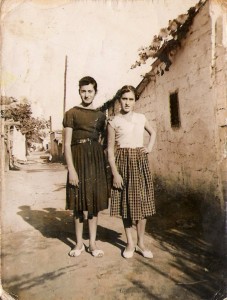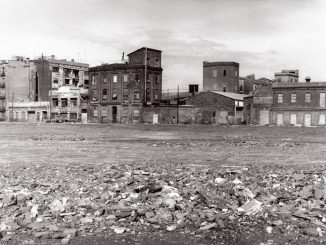
history

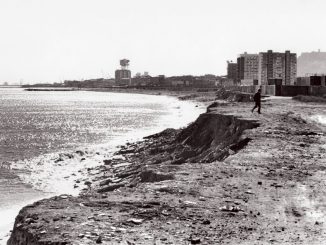
We have always been a frontier: Icària neighbourhood, before becoming the Vila Olìmpica
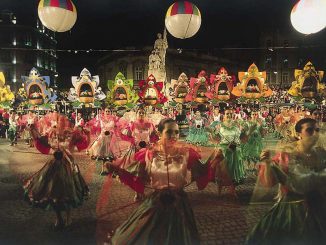
Two cities in the same Lisbon

Memories of the resistance: the Flor de Maig
The story of the city of Barcelona can be told focusing on its modifications: its urban plans, projects and transformations, i.e., on what changes. But the story of the city can also be told focusing on what remains, through what survives, what resists on the great void created by the struggles over the territory. Some elements – parks, places, buildings, corners – as classic sociologists said, maintain an identity, some relationships, and an enormous popular meaning. This is the case of Flor de Maig, the emblematic building of one of the big workers’ cooperatives of the XIX and XX century, which conveys the memory of Poblenou: a memory of struggles and resistance. Since 2012, some residents recovered the building, and transformed it into a place of denunciation against the neoliberal direction that the city of Barcelona is undertaking, or, as their website says, to give an answer to the needs, the challenges and the unsatisfied desires of the contemporary capitalist city. Will they succeed?
- José MANSILLA (2013) “Nunca nos fuimos. Frontera, Memoria y Resistencia en la Flor de Maig”, Paper delivered at III Jornades Doctorals d’Antropologia Social. University of Barcelona, June 5th and 6th, 2013. Barcelona.
- Webpage of Ateneu Flor de Maig :: Video of the day of the reopening :: Photos of the centenary on the webpage of the Historical Archive of Poblenou :: Sone history of the Ateneu on Històries del Poblenou webpage: part1 – part2
- Isaac MARRERO (2003) ¿Del Manchester catalán al SOHO barcelonés? La renovación del barrio del Poblenou en Barcelona y la cuestión de la vivienda.
- On the workers’ cooperatives in Barcelona: Marc DALMAU, Iván MIRÓ, Dolors MARÍN (2010), Les cooperatives obreres de Sants: autogestió proletària en un barri de Barcelona (1870-1939), Barcelona: La ciutat invisible.
- Our researches on Poblenou (2006): “El Pla de la Ribera: el veïnat contra la dictadura” :: Entrevistes a Can Ricart :: Video “Des del Ressentiment o la batalla de Can Ricart” :: Mapa de afectació de Can Ricart :: More posts on Poblenou

Peripheries of a colony: modernity as a challenge in Tetouan
“Immigrants from different places, spanish and moroccan, gathered in the neighborhood. […] About this part of Tetouan, we should write not a history but… a novel“. Mohamed Anakar, former resident of barrio Málaga.
Haussman and Cerdà’s modern urbanism was at its peak in Europe, when the Sultanate of Morocco fell under the military and economic pressures of France and Spain. So hispano-moroccan colonial cities grew as cities in an unlimited expansion; but at the margins of the m
edina and the “Ensanche” grid, popular neighborhoods developed, in which lower-class moroccan and spanish neighbors challenged the cultural and linguistic barriers, like a working-class dance in front of modernity. With El barrio Málaga video [link], and the exposition Tetuán desafíos de la modernidad [link] (recently opened in Casablanca) the interdisciplinary equipe of architect Alejandro MUCHADA proposes a post-colonial look on the hispano-moroccan city observed from its peripheries: where the lower classes cohabited and created their own city, outside all plannings, and in an overflowing melting pot.
- “Tetúanmodernchallenge” is a research of Gamuc.org group on the urban and social transformations during the 45 years of spanish occupation in the north of Morocco, through the lens of social housing: PDF of the expo presentet this april in Casablanca : presentation of the expo : Webpage Tetuán Modern Challenge
- The word challenge refers to the moroccan historian Abdallah LAROUI, who used it to describe what modernity represented for pre-colonial moroccan society. See also Josep Lluís MATEO (2007) “El interventor y el caíd. La política colonial española frente a la justícia marroquí durante el protectorado” [PDF]
- The historical critique allows us to identify what solutions were offered to this challenge in the field of housing. Architect Alfonso de Sierra Ochoa put forward a series of middle-scale projects, in which where involved Moroccans from Tetouan: through architecture, we can compare what modernity was imagined in that times, with the one Morocco has today.

Barcelona, irregular borders
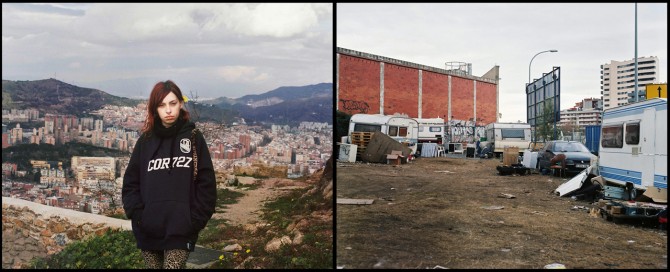 [/caption]
An unordered series of texts, images, webpages, books, reportages, about the differents Barcelonas that we can find between the sea and the mountain, between the Besós and the Llobregat river. Barcelona bordes irregulares [see photos][read text] is a photoreportage by Rosario Kuri (2012) that draws a casual drift for the peripheries, breaking the image of Barcelona's postcards and expressing the diversity of landscapes and people that form the city. La Rabassada o l'utopia de l'oci burgués [webpage] is a book published by Turiscòpia (2012) about the bourgeois casino on the Tibidabo mountain, at the beginning of the XX century. Projecte Icària [webpage][album] is a blog about Poblenou and its industrial heritage, with lots of photos by Marta Domínguez Sensada of the parts of the neighborhood demolished in the 90s . Los intelectuales contra el Raval [post] is a brilliant text by Rodulfo Rufián Roto on the symbolic violence of the mainstream media, in the occasion of the inauguration of Raval's film library. Los jóvenes del barrio, a 1982 video about Canyelles neighborhood (Roquetas), in Youtube. And an article of New Left Review online, "The Spanish model" by Isidro López & Emmanuel Rodríguez [english][spanish], and an essential contribution on the building of the negative myth on the barrio Chino: Chris Ealham (2005) "An imagined geography. Ideology, urban space and protest in the creation of Barcelona's 'Chinatown'", IRSH vol.50, ideal continuation of the famous "Geography of Evil" by Gary MCDONOGH (1987).
[/caption]
An unordered series of texts, images, webpages, books, reportages, about the differents Barcelonas that we can find between the sea and the mountain, between the Besós and the Llobregat river. Barcelona bordes irregulares [see photos][read text] is a photoreportage by Rosario Kuri (2012) that draws a casual drift for the peripheries, breaking the image of Barcelona's postcards and expressing the diversity of landscapes and people that form the city. La Rabassada o l'utopia de l'oci burgués [webpage] is a book published by Turiscòpia (2012) about the bourgeois casino on the Tibidabo mountain, at the beginning of the XX century. Projecte Icària [webpage][album] is a blog about Poblenou and its industrial heritage, with lots of photos by Marta Domínguez Sensada of the parts of the neighborhood demolished in the 90s . Los intelectuales contra el Raval [post] is a brilliant text by Rodulfo Rufián Roto on the symbolic violence of the mainstream media, in the occasion of the inauguration of Raval's film library. Los jóvenes del barrio, a 1982 video about Canyelles neighborhood (Roquetas), in Youtube. And an article of New Left Review online, "The Spanish model" by Isidro López & Emmanuel Rodríguez [english][spanish], and an essential contribution on the building of the negative myth on the barrio Chino: Chris Ealham (2005) "An imagined geography. Ideology, urban space and protest in the creation of Barcelona's 'Chinatown'", IRSH vol.50, ideal continuation of the famous "Geography of Evil" by Gary MCDONOGH (1987). 
Squatting in Europe
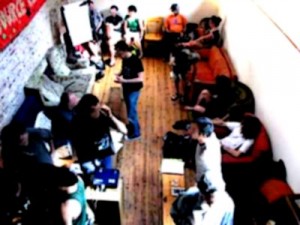 Squatting in Europe is a research network on the squatting movement in Europe. The origins of its members are very different: Brigthon, Madrid, Barcelona, Berlin, Copenhagen, Rotterdam, Roma, Catania, NewYork, Vermont, Amsterdam, Paris... so are their academic positions: some come from the universities, other are outside, some in between, and obviously shifting. From these diversities the members share a compromise and proximity with different expressions of the squatting movement, a practice of dialogue and reflection with the people who live these spaces, and an effort to publish works in free formats. Each meeting is held in a different city, always in squatted places, to share the debates with people living and using these spaces. Since 2009, the meetings have been in Madrid, Milan, London, Berlín, Amsterdam; the last one (december 2011) was in Copenhagen, in Bolsjefabrikken and Youth House. The results of the collective work and periodic meetings is obviously the enrichment of researches with the experience of the places visited, as well as the production of collective research from multiple perspectives.
Squatting in Europe is a research network on the squatting movement in Europe. The origins of its members are very different: Brigthon, Madrid, Barcelona, Berlin, Copenhagen, Rotterdam, Roma, Catania, NewYork, Vermont, Amsterdam, Paris... so are their academic positions: some come from the universities, other are outside, some in between, and obviously shifting. From these diversities the members share a compromise and proximity with different expressions of the squatting movement, a practice of dialogue and reflection with the people who live these spaces, and an effort to publish works in free formats. Each meeting is held in a different city, always in squatted places, to share the debates with people living and using these spaces. Since 2009, the meetings have been in Madrid, Milan, London, Berlín, Amsterdam; the last one (december 2011) was in Copenhagen, in Bolsjefabrikken and Youth House. The results of the collective work and periodic meetings is obviously the enrichment of researches with the experience of the places visited, as well as the production of collective research from multiple perspectives.
- Más información: Squatting in Europe SQEK manifesto - Squatting in Europe Research Agenda - Last meeting in Copenhagen - página en n-1
- The Bolsjefabrikken (candy factory) in Laerkevej, Copenhagen - where the last meeting was held - began a campaign to buy the building, under eviction [SEE PHOTOS][the webpage translated]
- Colin WARD (2002) Cotters and Squatters. Housing's hidden history. "If a man put up a cottage between sunset and sunrise and if he lit a fire on the hearth and sent smoke through a chimney, it was a recognised custom that he might remain in possession of the house although it was built on common land" [Download PDF]

Herstory of the revolution: words of rebel egyptian women
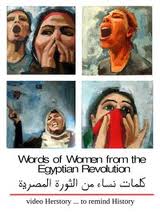 "Allowing my daughter to sleep in Tahrir, of course, was a revolutionary decision. This is the effect of the revolution on our way of thinking and dealing with things".Hanan Sadek, 52, works in an oil company
"I'll never forget the way that soldier looked. He wouldn't look at me, he was looking away. Deliberately trying to avoid eye-contact with me, and he was crying. Then all at a sudden they all started to shoot at the same time" Sanaa Seif, 17, student
"We were living with our eyes closed. We didn't use to see what is in front of our eyes" Mona Hussein, 50, housewife
Every week, the independent equipe of Leil-Zahra MORTADA uploads in "Words of Women from the Egyptian Revolution" a short video: the revolution should not be explained as dominant history always does, as virile adventures of heroes and martyrs. Herstory is the version that even revolution enthusiasts try to keep silent: because the existence of rebel arab women is too big a contradiction for the standard version of history.
"Allowing my daughter to sleep in Tahrir, of course, was a revolutionary decision. This is the effect of the revolution on our way of thinking and dealing with things".Hanan Sadek, 52, works in an oil company
"I'll never forget the way that soldier looked. He wouldn't look at me, he was looking away. Deliberately trying to avoid eye-contact with me, and he was crying. Then all at a sudden they all started to shoot at the same time" Sanaa Seif, 17, student
"We were living with our eyes closed. We didn't use to see what is in front of our eyes" Mona Hussein, 50, housewife
Every week, the independent equipe of Leil-Zahra MORTADA uploads in "Words of Women from the Egyptian Revolution" a short video: the revolution should not be explained as dominant history always does, as virile adventures of heroes and martyrs. Herstory is the version that even revolution enthusiasts try to keep silent: because the existence of rebel arab women is too big a contradiction for the standard version of history. 
Two new books about Barcelona
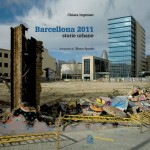 These two freshly published books by Chiara Ingrosso provide new insights on Barcelona's urban and architectural history: the first analizes the city transformations from Franco's dictatorship to future urban plans; the second draws a route around four neighborhoods, Barceloneta, Poblenou, La Mina and Bon Pastor. Both of them are illustrated with Mario Spada photographies, and, as a whole, they show the catalan capital very different as how it is usually represented in Europe and in the whole world, underlining its several dark sides.
These two freshly published books by Chiara Ingrosso provide new insights on Barcelona's urban and architectural history: the first analizes the city transformations from Franco's dictatorship to future urban plans; the second draws a route around four neighborhoods, Barceloneta, Poblenou, La Mina and Bon Pastor. Both of them are illustrated with Mario Spada photographies, and, as a whole, they show the catalan capital very different as how it is usually represented in Europe and in the whole world, underlining its several dark sides.
- C. INGROSSO, “Barcelona. Architecture, City and Society”, Skira, Milán
- C. INGROSSO, “Barcellona 2011. Storie urbane”, Clean, Nápoles

Photos: Barcelona’s Montjuïc
Four photos of Montjuïc mountain, when there still were people living on it. Even if for history it was only “slums”, many of them remember houses, written records, roads and street numbers. These photos come from private collections of former residents of “Eduardo Aunós” neighborhood. The old slum dwellers, almost all of them from Murcia or Andalusia, had to leave their houses in the 1920s, because of the celebration of an Universal Exposition. They were relocated in the Casas Baratas, but then their sons and nephews were evicted again at the end of the century. The need for land hit again those immigrant families; and it doesn’t matter how many generation they had been living in their “welcoming land”.…

The forgotten mountain: everyday geopolitics in Sarajevo
 “Do you know when was it the last time I climbed on Trebević? February 1992. I used to go there every weekend with my father. I never went again. From that mountain 22 grenades fell onto the roof of our house. Now I see it everyday from my window, and I just want it to disappear”. Bojan, 30-years-old Sarajevan.[br]The inhabitants of Sarejevo (Bosnia-Herzegovina) don't climb any more on Trebević mountain, even if the war ended 15 years ago; the restaurants and panoramic terraces are destroyed, the cable car that connected it with the city never worked again, and, most of all, there are parts of it where there still could be landmines. But it's not lack of money the main reason why the city administration is keeping Trebević in this state of "no man's land": the divided city is useful for both nationalisms, and an invisible barrer separating "us" from "them" undermines the postwar coexistence project and the dream of a city that could be universal again.
“Do you know when was it the last time I climbed on Trebević? February 1992. I used to go there every weekend with my father. I never went again. From that mountain 22 grenades fell onto the roof of our house. Now I see it everyday from my window, and I just want it to disappear”. Bojan, 30-years-old Sarajevan.[br]The inhabitants of Sarejevo (Bosnia-Herzegovina) don't climb any more on Trebević mountain, even if the war ended 15 years ago; the restaurants and panoramic terraces are destroyed, the cable car that connected it with the city never worked again, and, most of all, there are parts of it where there still could be landmines. But it's not lack of money the main reason why the city administration is keeping Trebević in this state of "no man's land": the divided city is useful for both nationalisms, and an invisible barrer separating "us" from "them" undermines the postwar coexistence project and the dream of a city that could be universal again. 
The “Reconquista” of Alcoi (Valencia)
 The transformation of the center of Alcoy, the most ancient industrial city in Spain, between Valencia and Alicante, entails great demolitions in the Partidor neighborhood, cradle of the spanish working class movement. The City Council is buying the buildings of the neighborhood one by one, then evicts its inhabitants, fostering deterioration and creating an excuse for their demolition. In the name of common good, and of the improval of urban life, all around Spain the historical places of the working class are under attack, like if history was only the history of the ruling classes; this process is even more dramatic where there were strong struggles and rebellions against the new-born capitalism. "The shame of having to attend to your own funeral", as sang by Alcoi's poet Ovidi Montllor, about the reconstruction of a steeple burned during the Civil War.
The transformation of the center of Alcoy, the most ancient industrial city in Spain, between Valencia and Alicante, entails great demolitions in the Partidor neighborhood, cradle of the spanish working class movement. The City Council is buying the buildings of the neighborhood one by one, then evicts its inhabitants, fostering deterioration and creating an excuse for their demolition. In the name of common good, and of the improval of urban life, all around Spain the historical places of the working class are under attack, like if history was only the history of the ruling classes; this process is even more dramatic where there were strong struggles and rebellions against the new-born capitalism. "The shame of having to attend to your own funeral", as sang by Alcoi's poet Ovidi Montllor, about the reconstruction of a steeple burned during the Civil War. 
Links on protests in Maghreb
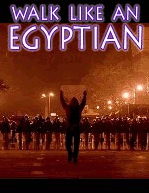
- José SÁNCHEZ GARCÍA (2011) “La revolución egipcia: jóvenes, política y sociedad“. (also in italian) Download his thesis “Juventud en sociedades árabes: ¿cómo construyen su identidad?” (2009) in PDF: 1-2-3.
- Issandr EL AMRANI "Why Tunis? Why Cairo?", London Review of Books, 4/2/2011
- Santiago ALBA RICO "Y de pronto, la revolución" Gara, 17/1/2011
- Gabriele DEL GRANDE "The dictatorship south of Lampedusa" Peacereporter, 10/11/2008
- “Insurrection in North Africa: the story so far“ Libcom, 17/1/2011 (in spanish in Indymedia Estrecho and Klinamen)

A competition of ideas against the demolition of a popular neighborhood

More on Barcelona’s city center: “The Melody of Raval”, by Manuel Vázquez Montalbán
 "Here we were all born in leftover neighborhoods, rounded by leftovers, waiting to grow up, to get old, or better said, to deconstruct ourselves; so we can receive all your sociologists, all your social psychologists, your substitute mayor, your worst dressed politician, the sons of your good neighborhoods that will give us examples on how to use abilities and efforts to help us out of the leftover neighborhoods; this is, you give us your leftover social science, your leftover psychology, your leftover mayor, your leftover solidarity, even your leftover fear, for sometimes you think that you yourselves could have been born in the leftover neighborhoods, that you could be leftovers yourselves; this is why you come down here to look at us playing the part of the assisted classes, useless even for production because robotics replaced us, and because our condition of leftovers can't compete anymore with leftovers from even more impoverished parts of the planet.
"Here we were all born in leftover neighborhoods, rounded by leftovers, waiting to grow up, to get old, or better said, to deconstruct ourselves; so we can receive all your sociologists, all your social psychologists, your substitute mayor, your worst dressed politician, the sons of your good neighborhoods that will give us examples on how to use abilities and efforts to help us out of the leftover neighborhoods; this is, you give us your leftover social science, your leftover psychology, your leftover mayor, your leftover solidarity, even your leftover fear, for sometimes you think that you yourselves could have been born in the leftover neighborhoods, that you could be leftovers yourselves; this is why you come down here to look at us playing the part of the assisted classes, useless even for production because robotics replaced us, and because our condition of leftovers can't compete anymore with leftovers from even more impoverished parts of the planet. 